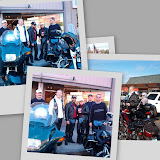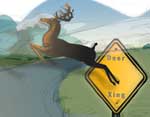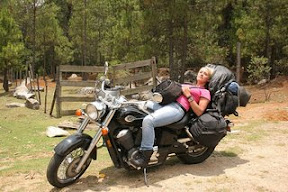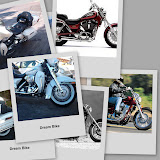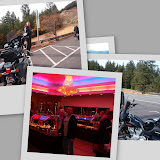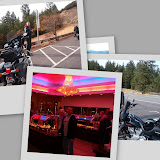
Riding curves (Reprinted w/o permission as originally published, article from Cruiser Magazine)
Any number of roadside objects can block your view of the road ahead. So what do you do? Well, I don’t commit myself to more than I can see. I reduce my speed and, if conditions permit, enter the bend on the outside of my lane, which normally gives me the best and earliest view of the road ahead. As I proceed around the corner, my eyes repeatedly trace the line I plan to take as far as I can see up the road and back to a short ways in front of the bike. The standard recommendation is to look as far as you can up the road, but perhaps because my vision is less than perfect, I want to double-check and reevaluate the road surface as I get closer. When I can see all the way to the exit, only then do I commit to leaning over hard.
Motorcycle Cornering Safety Tips in Turns and Corners with Hazards
How to safely prepare, detect, and deal with obstacles and hazards you encounter while riding through turns and corners on a motorcycle. From the April 2006 issue of Motorcycle Cruiser magazine. By Art Friedman.
Blind corners must be approached with more caution, less speed, and a bit of imagination to let you consider might be hidden just around the bend. Photography by Kevin Wing
It could be that my favorite thing about riding motorcycles is the way they turn, leaning over to balance all the forces involved in making a single-track vehicle change directions and go right where you want it. Even after riding through corners hundreds of thousands — probably millions — of times, the process of riding a motorcycle around a turn in the road or racetrack is still exciting and challenging. I’m also sure that there haven’t been more than a handful of times in more than 40 years and a million miles of riding that I arrived at the entry to a corner and entered it just perfectly, with exactly the right amount of handlebar pressure, body English, throttle opening and lean angle to deliver me to the ideal point at the apex of the turn without minute adjustments. You virtually always have to make some sort of adjustment as you commit to a line around the turn. To keep all those forces balanced, you can’t make any violent changes or you’ll quickly find yourself flat-side-down. To avoid doing that, you need to to be sure of what lies ahead .
Yet the moment of commitment to a corner is the crucial one, and the way you do it should depend almost entirely on what you see as the corner appears ahead of you. Maybe you have ridden it thousands of times. Maybe this is your first time drawing an arc on this particular stretch of pavement. But even in a corner that I ride every day, one where I know every crack and ripple in the asphalt, I can’t commit until my eyes have evaluated the surface first. Even if you have ridden through just minutes before, the situation may have changed. A car might have stopped just behind the embankment or bushes that hide the exit to the corner, or a passing vehicle could have left oil, water, sand, tacks, a ladder, an inflatable wading pool or hundreds of other things in the corner that will upset the perfect balance you created on your last pass.
So before I commit, I need to be able to observe and evaluate the entire surface I will ride across while I’m leaning over. Many turns don’t permit you to see completely through them as you arrive. Any number of roadside objects can block your view of the road ahead. So what do you do? Well, I don’t commit myself to more than I can see. I reduce my speed and, if conditions permit, enter the bend on the outside of my lane, which normally gives me the best and earliest view of the road ahead.
However, there are circumstances where entering a curve wide may not be the best approach. A wide entry to a right-hander means you are closer to the centerline and therefore more likely to come eyeball-to-hood-ornament with a car (or another rider) that has crossed the center line to straighten out the corner. And if the corner is questionable — say it looks sandy or greasy — straightening up in response to that squirming sensation from your tires could make you cross the center line. In that situation, I’ll forego the added up-the-road visibility and tiptoe around the inside of my lane at a speed that permits me to respond to anything I might encounter. Just imagine that there may be a boulder up ahead and you’ll probably approach at a safe speed. I have learned that this is easier to visualize once you have actually come around a turn and found a recently arrived boulder there to greet you.
As I proceed around the corner, my eyes repeatedly trace the line I plan to take as far as I can see up the road and back to a short ways in front of the bike. The standard recommendation is to look as far as you can up the road, but perhaps because my vision is less than perfect, I want to double-check and reevaluate the road surface as I get closer. When I can see all the way to the exit, only then do I commit to leaning over hard.
Unfortunately, not all hazards are visible. Freshly spilled diesel fuel and some coolants are virtually invisible on the road surface, though your nose can often alert you to their presence. A thin sprinkling of sand can reduce traction but can be very hard to spot, and you certainly won’t smell it.
Lighting can also limit you. A low sun glaring into your eyes can make it very difficult to see much of anything, and I frequently end up riding one-handed as I use my left hand to shade my eyes in this situation. A low-hanging sun can also throw shadows across turns. On more than one occasion I have watched a rider dive into a shady corner and emerge sliding on his butt after encountering sand, leaves or some other slippery material hidden in the shade.
Shade can actually create a hazard. The coastal mountains around Los Angeles frequently get a nice coating of dew overnight, and the winding roads that traverse them are often slippery until the sun reaches them and dries the dew. However, during the winter months, the sun may never get high enough to remove the dew from a corner, so the shaded portion remains wet all day. These moist patches will often exactly match the shaded area, making it very difficult to tell that the road is wet unless you are aware of this situation. In colder places, the shaded area may hide black ice, and in fact this dew sometimes freezes on cold nights, even in the SoCal mountains.
Anyway, whether it’s shaded dew, sand, oil or a warthog, any hazard that you discover on your intended line as the turn reveals itself requires an alternate plan. If you have entered the corner at a reduced speed, you should have enough reserve traction to do some braking, even though you are leaned over. The slower you are going, the more options you have, including perhaps stopping. And if your only option ends up being an off-road excursion, reducing your speed means you will do less damage to the guardrail or tree that you hit.
If you are going slow enough, you can simply straighten up and ride across something slippery. If the hazard is in the middle of the lane, with some reserve in hand you can go around it. I prefer to tighten my line and go inside, because that allows me more options for the rest of the turn if there are further hazards. Also, if I misjudged, I can straighten up and still have pavement left to use for further slowing and changing my line. Going around a hazard on the outside often leaves you leaning over close to the edge of the road, so there is no room to straighten up and remain on the road if things don’t go according to plan.
Fortunately, there are plenty of brightly lit, perfectly clean corners that you can see all the way through before you have to commit to a line and speed. Those are what make all the dirty, slimy, frog-infested ones worthwhile.
Fighting Fatigue on Long Motorcycle Rides
Motorcycling is more physically demanding that driving a car and exposes you to the environment, which can lead to fatigue. To avoid becoming tired on long motorcycle rises, you need to get adequate rest, plan and prepare, consume the right food and drink, and set up your bike properly. From the June 2006 issue of Motorcycle Cruiser magazine. By Art Friedman.
Illustration by John Breakey
Experts say that fatigue contributes to between a fifth and a sixth of all car accidents. That may not be true in motorcycle accidents across the board, but fatigue is definitely an issue for riders on trips of three days or more. It’s something that you need to consider and prepare for. If you are riding with other people, it is an issue that you should discuss and accommodate as you plan your trip. Different riders will have different requirements for rest, and if the trip is to be a safe one, all members of the group should be willing to accommodate each other.
Before you head out on the highway looking for adventure, coniser a few steps that you can take and plans you can make to avoid having one of your adventures involve falling asleep on your motorcycle.
Rest:
Adequate sleep can be a bit hard to come by before and during a multi-day ride. I am always thinking of things I want to do or remember to bring as I try to get to sleep on the night before I depart. I also have trouble getting to sleep while traveling. Many people also have trouble getting a full night’s sleep as they get older. If I combine that with early departures, I quickly have a sleep deficit. For that reason, I like to plan to allow myself to sleep late every two or three days, setting no departure time.
Don’t use alcohol as a sleep aid; it actually tends to reduce both the quantity and quality of sleep. You might think that you can’t fall asleep on a motorcycle, but I have known riders who simply fell asleep while riding, waking up as they bounced through a ditch — or in the hospital. Riders who experienced these sorts of adventures often said they didn’t even realize they were tired.
Experts say that you’ll have “tired times” during every 12-hour cycle, most often between 3:00 and 5:00 (a.m. and p.m., you local time). You may want to plan to arrive by that point or stop for an early dinner. If you can or need to, take a day off just to relax and catch up on your sleep.
Physical Preparation:
Unless you ride your motorcycle almost every day or take rides of three hours or more almost every weekend, you may not be completely adapted to your bike. After a full day or two of riding, you will become acutely aware of muscles that you are using full-time to ride. You may be able to overcome some of this discomfort by properly setting up your bike and fitting components, such as a good aftermarket saddle, that make it more comfortable. However, you also need to give your body a chance to adapt. Taking breaks every hour or two, especially during the first few days of a long ride, will help this adjustment.
Calm:
Extended exposure to wind and sun dehydrates and fatigues you much more than your routine two-hour weekend jaunt. Riding in a tanktop and open-face helmet may seem like the best way to deal with the heat, but will actually wear you out and heat you up much faster than if you wear a vented or mesh jacket and a helmet that protects your face from the wind. Perspiration gets a chance to stay on and cool your skin if the wind flow is reduced but not eliminated. You will sharply reduce sunburn and windburn and their fatiguing effects by covering yourself fully. A windshield also reduces the amount of wind that’s tearing at you but leaves enough to cool you.
Quiet:
Wind noise (and exhaust noise if you have loud pipes) will not only permanently damage your hearing, it will fatigue you quickly. Both noise sources are at their worst if you don’t wear a helmet, but even a full-face helmet that seals your ears well won’t attenuate these noise sources sufficiently on an extended ride, so you should wear earplugs as well. If nothing else, you’ll appreciate them when you try to go to sleep at night and the roaring in your ears isn’t as loud. A windshield can also reduce wind noise.
Clear:
Vision clarity can be an issue on extended rides too. About 15 years ago we did a comparison test where one bike had significant distortion in the top of its windshield. Several riders said riding it made them feel disoriented or tired or gave them headaches. If your windshield creates this problem, or if you have a faceshield or sunglasses that are optically imperfect, you should find a replacement or eliminate the problem, perhaps by trimming the top of your windshield. If your vision has changed so that your prescription is no longer adequate, update it before you leave.
Caffeine and Alcohol:
A coffee or cola can briefly boost your alertness, but isn’t a substitute for adequate rest. Having a beer before or during a ride is a bad idea for many reasons, but especially if you are slightly tired or fatigued. Discouraging your riding companions from having one also does both of you a favor.
Good Habits:
Those boring admonitions about diet and exercise also apply to fighting fatigue. They increase your energy level, which makes you stronger and more alert. Of course, drinking adequate water is important too, especially considering that you are being dehydrated more rapidly because of your exposure to the wind. I don’t hold with the theory that you aren’t drinking enough if you don’t have to urinate every 30 minutes though.
Fighting fatigue provides benefits that go beyond safety. If you are alert and refreshed, the ride itself is more enjoyable, and you’ll get more out of the sights and experiences that you came to enjoy.
Labels: Safety tips
 (Click photo to hear & see video)
(Click photo to hear & see video)
